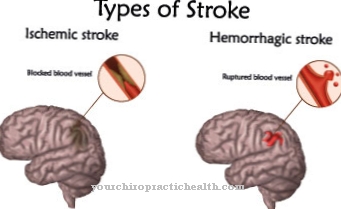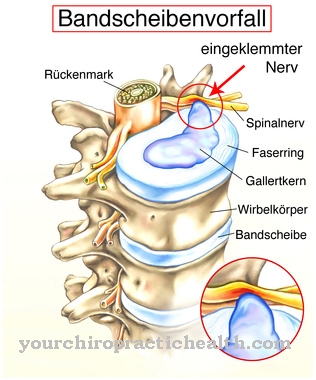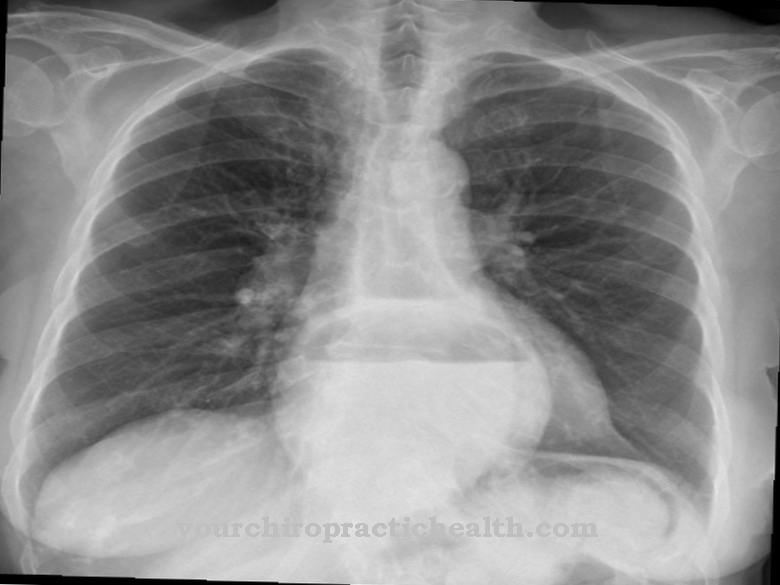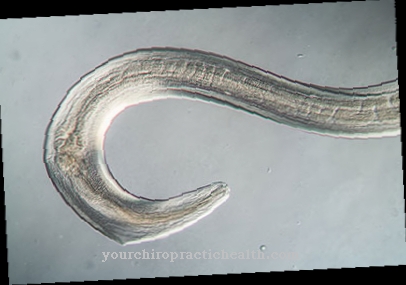gout or Hyperuricemia is a well-known metabolic disease. This leads to an increase and concentration of uric acid in the blood, which in its effect mainly leads to severe joint inflammation and joint pain. One differentiates mainly between acute gout attack and chronic gout.
What is gout?

© Henrie - stock.adobe.com
Gout or hyperuricemia, which used to be called Niggles was known to be a metabolic disease. Typical of gout is the accumulation of uric acid in the blood, from which uric acid crystals form over time. These are then deposited in the joints, tendons and bursa. In the course of this, severe pain occurs in the area of the joints (joint inflammation), which usually results in irreversible joint damage.
Furthermore, gout can be divided into two forms:
1. Primary gout: The body produces more uric acid than it excretes through the kidneys and bladder. Uric acid builds up in the body.
2. Secondary gout: With this form, sustained damage has already occurred through uric acid production and its accumulation in the body. For example, kidney failure can be held responsible for the death of cells.
Gout is common in people with a high standard of living. It mostly affects men of a more mature age (between 40 and 60 years of age).
causes
The causes of gout are not yet fully understood. However, it is assumed that genetic causes trigger gout in most cases. Hereditary predisposition can lead to the production of too much uric acid. A genetic defect can also be the reason why not enough urea is excreted.
In the course of this, the urea crystals are deposited in the blood and migrate to the joints, tendons and bursa of the joints. Joint inflammation develops, which can be very painful. Other causes can be a metabolic disorder in which purines, which are mainly found in meat and offal, cause an overproduction of urea.
Especially people who consume a lot of meat and alcohol can get gout. Acute gout attacks are also possible in these sufferers.
Symptoms, ailments & signs
At first, gout is often only noticeable in one joint. In the first stage there is only an increased uric acid level, which does not yet cause any clear symptoms. The first signs can be kidney stones or an acute attack of gout. In the second stage, severe pain occurs in individual joints.
Usually the joints of the feet and toes are affected; in around eight percent of cases, the symptoms affect the joints of both feet. The first gout attack usually occurs during the night and can last for several days. Signs of inflammation are often noticed in the affected joint. The joints then take on a noticeable reddening, are sensitive to touch and overheated.
The skin over the affected joint may peel or itch. Occasionally, an attack of gout is associated with additional symptoms. Typically, there is a fever, headache or palpitations. In some sufferers, gastrointestinal complaints are added. Sick people also feel weak and their performance is limited.
After several attacks of gout, the mobility of the joints also decreases, combined with further pain and swelling. People are symptom-free between attacks. Chronic gout manifests itself in that the symptoms persist and increase in intensity over time.
course
The course of gout can take place without further complications if the doctor diagnoses the disease in a timely manner. The uric acid level in particular should be examined in particular as part of a diagnosis. If, on the other hand, no treatment is found, the gout can develop into chronic gout.
The course of untreated gout is as follows: 1. acute gout attack, 2. intercritical gout phase, 3. chronic gout.
Complications
Without proper treatment of gout, the people affected are at risk of various sequelae. Deformations of the joints and soft tissue nodes are typical complications of gout. If an acute gout attack occurs, this usually results in severe pain. The inflammatory reaction can also lead to a fever.
The gout attack usually heals without any additional effects. However, further attacks are not uncommon. If there is no professional treatment in which the uric acid level in the body is lowered, the gout attacks appear at ever shorter intervals. This increases the risk that joints and bones will be permanently damaged.
As a result, the patient continues to suffer from swollen, sore, and immobile joints. In addition, the affected joint appears red and overheated. In the case of chronic gout, crystal deposits can develop on different parts of the body, which can be seen on the X-ray. Medical professionals refer to these deposits as gouty tophi. However, they rarely occur.
Another negative effect of gout is the rise in uric acid levels, which can impair the kidneys. This includes the formation of kidney stones that result from uric acid deposits. They in turn pose a risk of painful renal colic. They also promote kidney infections and urinary tract infections. Sometimes the amount of uric acid in the kidney increases to such an extent that an acute failure of the organ occurs.
When should you go to the doctor?
People with unusually light or white skin should consult a doctor to be on the safe side. If there is swelling of the joints, pain in the bones and restricted mobility, a doctor is required. Before taking any pain medication, it is essential to consult a doctor to avoid further illnesses.
If the pain spreads or the swelling increases in size, a doctor should be consulted immediately. If several joints are affected as the disease progresses, the change must also be presented to a doctor. If the motor restrictions lead to one-sided strain on the body or a poor posture, a doctor is required. Reddening of the skin, increased body temperature and hot joints are cause for concern. A doctor's visit is required so that treatment can be initiated.
If dizziness, nausea or vomiting occurs repeatedly, a doctor should be contacted. Consultation with a doctor is necessary in the event of inner restlessness, irritability or increased stress. If the day-to-day obligations at work or in private life can no longer be carried out as usual, a doctor should be consulted. A doctor is also required if psychological problems arise. Help should be sought in the event of emotional or psychological impairments or behavioral problems.
Doctors & therapists in your area
Treatment & Therapy
A gout disease should definitely be examined and treated by a doctor, otherwise life-threatening complications or kidney failure can set in. Therapy for gout mainly focuses on lowering the level of uric acid in the blood. Furthermore, the unpleasant accompanying symptoms should be alleviated.
Above all, the joint pain, swellings and body aches are the focus of gout therapy. In addition, a chronic gout disease should be prevented with medical treatment. The following medication can be considered: anti-inflammatory anti-inflammatory drugs for severe gout progress, cortisol-containing glucocorticoids as pain relievers and anti-inflammatory drugs and / or colchicine for acute gout attacks to relieve jelly pain. However, colchicine does not lower uric acid levels and is therefore only intended for symptom relief.
In the self-treatment, cold compresses of the affected joints are recommended. These extremities should also be kept still. In addition, it is advisable to drink plenty of fluids to lower the urea concentration. In any case, alcohol and fatty meat dishes should be avoided.
Outlook & forecast
Although gout is not curable, it responds very well to drug treatment. Disciplined patients who stick to a low-purine diet can have a positive effect on the prognosis.
The first attack usually subsides on its own after one to two weeks. Many of those affected are pain-free for a long time afterwards, but it is advisable to start taking uric acid-lowering medication immediately. This can prevent further attacks from occurring.
Uricopathy patients have a significantly increased risk of cardiovascular disease and diabetes mellitus. Avoiding meat, alcohol and an excess of sugar reduces the risk of these secondary diseases. Male patients particularly benefit from changing their eating habits.
If left untreated, the disease progresses in relapses that become more frequent and eventually become chronic. The joint surfaces are destroyed, irreversible thickening and deformation of the joints occurs. Typical consequences of chronic gout are so-called tophi. These are painless urate deposits just under the skin. They are usually located on the auricle and near the joints.
In the worst case, uric arthritis leads to kidney damage, which can manifest itself in kidney inflammation or even acute kidney failure.
prevention
Gout can be prevented relatively well. This includes avoiding a fatty and meat-rich diet. Likewise, alcohol should not be drunk, as this can lead to an increase in uric acid concentration. Drink a lot to dilute the urea and flush it out faster.
Aftercare
As part of the gout follow-up care, the uric acid level is checked regularly to check the medication setting. Depending on the results of the examination, the medication can be adjusted or retained. If necessary, diet, physical activity and other components of the therapy are also checked.
The follow-up checks initially take place several times a year and can be reduced if the disease progresses positively. If the symptoms do not decrease or even get worse, long-term therapy is indicated. The purine metabolism needs to be regulated in order to alleviate the typical symptoms and to achieve a long-term recovery.
After an acute attack of gout, the patient must take it easy and continue to cool the affected area. During the follow-up care, the causes of the disease are determined in order to enable optimally adapted therapy. Likewise, possible triggers such as alcohol or diets high in purine must be avoided, as these worsen the symptoms in most cases.
After an operation, as is necessary for arthritically damaged joints, rest and rest again. The patient must undergo a follow-up after one to two weeks and visit the responsible internist and, depending on the symptoms, other specialists for the medical check-up at regular intervals.
You can do that yourself
If you have gout, you should always consult a doctor. Depending on the cause, the doctor will prescribe suitable drugs and conventional medical measures. To support the initial treatment, those affected can take some self-help measures.
In the event of an acute attack, it is important to cool the inflamed joints with compresses or pads. The affected limbs should be raised and moved as little as possible. At the same time, plenty of water or tea should be drunk so that the crystals are excreted quickly. Alcohol should be avoided. Likewise, on foods rich in purine such as offal, roasts, seafood, yeast-containing foods, spinach and cauliflower.
Cherries are an effective home remedy for gout. The fruit contains anti-inflammatory substances, which at the same time neutralize uric acid in the blood and relieve pain. Other foods that help in the excretion of uric acid (such as celery or radishes) may also be consumed more during a gout attack.
From then on, sufferers should address the causes of gout. Obese people should aim for weight loss, while alcoholic people should seek therapeutic help. If you have kidney disease or type 2 diabetes, long-term therapy with specialist support may be necessary.


.jpg)
.jpg)























